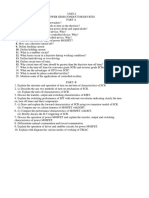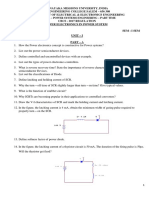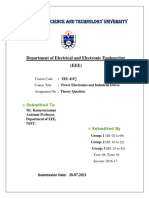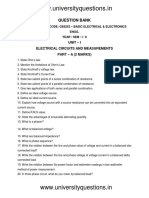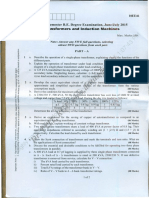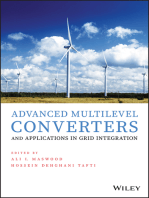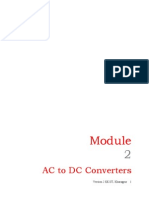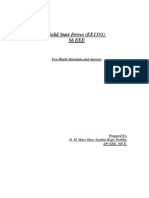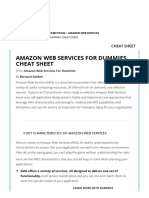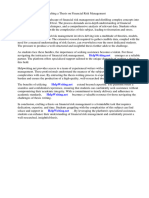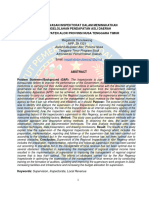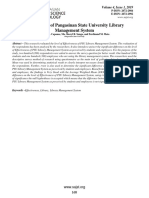Kings: Question Bank
Kings: Question Bank
Uploaded by
api-19951707Copyright:
Available Formats
Kings: Question Bank
Kings: Question Bank
Uploaded by
api-19951707Original Title
Copyright
Available Formats
Share this document
Did you find this document useful?
Is this content inappropriate?
Copyright:
Available Formats
Kings: Question Bank
Kings: Question Bank
Uploaded by
api-19951707Copyright:
Available Formats
EE 1301- POWER ELECTRONICS
KINGS
COLLEGE OF ENGINEERING
DEPARTMENT OF ELECTRICAL AND ELECTRONICS ENGINEERING
QUESTION BANK
SUBJECT CODE & NAME: EE 1301 – POWER ELECTRONICS
YEAR / SEM: III / V
UNIT – I
POWER SEMI-CONDUCTOR DEVICES
PART - A
1. Define latching and holding current. (2)
2. What are the factors that influence the turn off time of a thyristor? (2)
3. What is reverse recovery time? (2)
4. Give the applications of BJT? (2)
5. Differentiate MOSFET and IGBT. (2)
6. Why are IGBT becoming popular in their application to controlled converters? (2)
7. Differentiate BJT and MOSFET. (2)
8. What do you mean by commutation? (2)
9. What are the advantages of MOSFET? (2)
10. Give the applications of TRIAC. (2)
PART - B
1. a) Discuss the different modes of operation of thyristor with the help of static
VI characteristics. (8)
1. b) Explain the construction of SCR with neat sketch. (8)
2. Draw the switching characteristics of SCR and explain it. (16)
3. Discuss the different modes of operation of TRIAC with the help of VI
characteristics. (16)
4. Explain the switching characteristics of TRIAC (16)
5. With the help of neat diagram explain the operation of BJT. (16)
6. Draw the basic structure of an IGBT and explain the operation. (16)
7. Draw the transient characteristics of IGBT and explain it. (16)
8. Explain the construction and operation of power MOSFET. (16)
KINGS COLLEGE OF ENGINEERING, PUNALKULAM
EE 1301- POWER ELECTRONICS
9. Explain the switching characteristics of MOSFET. (16)
10. Explain the driver circuit and protection circuits for MOSFET. (16)
UNIT II
PHASE-CONTROLLED CONVERTERS
PART - A
1. What is two pulse converter? (2)
2. What is full converter? Mention its uses. (2)
3. What is a delay angle of converters? (2)
4. What is the principle of phase control half wave rectifier? (2)
5. What is the function of freewheeling diode in semi converter? (2)
6. Draw the three phase half wave converter. (2)
7. It is required to operate a 1Φ full converter in inverter mode with RLE load.
Should the output average voltage be more or less than E during inverter
operation. Why? (2)
8. Write the expression for 3Φ full converter with RL load. (2)
9. What is the effect of source inductance and write the expression for the overlap
angle. (2)
10. Explain the phase voltage controllers. (2)
11. What is meant by distortion factor? (2)
12. Explain the ripple factor and displacement factor. (2)
13. Differentiate unidirectional and bi-directional ac voltage controllers (2)
14. What are the difference between Freewheeling Diode and feedback diode? (2)
PART - B
1. Discuss the working of 1Φ two pulse bridge converter with RLE load using
relevant waveforms. (16)
2. A 1Φ two pulse bridge converter feeds power to RLE load with R=6Ω, L= 6mH,
E = 60v, ac source voltage is 230v, 50Hz for continuous conduction. Find the
average value of load current for firing angle of 50 °. In case one of four SCR’S
gets open circuited. Find the new value of average load current assuming the
output current as continuous. (16)
3. a) Explain the operation of 1Φ semi converter and derive the expressions for its
average and rms output voltage. (8)
3. b) Derive the expressions for harmonic , displacement and power factor of a 1Φ
full converter from the fundamental principle. (8)
4. Explain the working of 1Φ full converter with RL load and derive the expression
for the average and rms value. (16)
KINGS COLLEGE OF ENGINEERING, PUNALKULAM
EE 1301- POWER ELECTRONICS
5. Explain the working of 3Φ full converter for highly inductive load with the help
of waveforms. (16)
6. A 3Φ full converter operates from 3Φ 415v, 50Hz supply. The load is highly
inductive. Determine the triggering angle of the converter to get average output
voltage of 300v. The load is R=10ohm. Determine the load current and
power. (16)
7. Explain the operation of 3 pulse converter with RL load and derive expression for
average and rms value. (16)
8. Explain the effect of source inductance on the output of converters and derive
expression for reduction in output voltage and overlap angle. (16)
9. Explain the operation of 1Φ ac voltage controller with R load and compare with
all other configurations of ac voltage regulator. (16)
10. A 1Φ voltage regulator feed power to R=3 ohm load from 230v, 50Hz source.
Find i) Maximum value of average and rms thyristor currents for any firing angle.
ii) Minimum circuit turn off time for any firing angle
iii) Ratio of third harmonic voltage to fundamental voltage for 60° (16)
11. A 3Φ half wave converter is operated from a three phase star connected 220v,
60Hz supply and the load resistance is R=10 ohm. If the average output voltage
is 25% of the maximum possible average output voltage. calculate i) delay angle
ii) Rms and average output current iii) average and rms thyristor currents.
iv) Rectification efficiency (16)
UNIT III
DC TO DC CONVERTERS
PART - A
1. Define the term duty cycle of dc choppers. (2)
2. Differentiate between constant frequency and variable frequency control
strategies of varying duty cycle of dc choppers. (2)
3. Distinguish step down and step up converters. (2)
4. Give the applications of choppers. (2)
5. Explain the buck-boost converter. (2)
6. What do you know about cuk converter? (2)
7. What are the applications of switching mode regulators? (2)
8. What is the advantage of buck-boost converter? (2)
9. Explain the SMPS. (2)
10. What is the advantage of resonant switching based SMPS? (2)
11. What do you mean by buck regulator? (2)
12. Explain the principle of resonant switching regulator. (2)
13. A dc chopper of input voltage 200v remains on for 200ms and off for 10 ms.
Determine average load voltage. (2)
KINGS COLLEGE OF ENGINEERING, PUNALKULAM
EE 1301- POWER ELECTRONICS
PART - B
1. Discuss the principle of operation of DC-DC step down chopper with suitable
waveforms. Derive the expression for its average dc voltage. (16)
2. A step down dc chopper has input voltage of 230v with 10 ohm load, voltage
drop across chopper is 2v, when it is on. For a duty cycle of 0.5.
Calculate i) average and rms value of output voltage ii) power delivered to the
load. (16)
3. Explain the two quadrant dc chopper operation with RLE load using suitable
waveforms. (16)
4. a) Explain time ratio control and current limit control strategies. (8)
b) Explain the resonant switching based SMPS. . (8)
5. Explain any one type of switched mode regulator and derive the expression
for it. (16)
6. Describe briefly the principle of operation of buck boost converter with a neat
circuit diagram. (16)
UNIT IV
INVERTERS
PART - A
1. Differentiate half bridge and full bridge inverter. (2)
2. What are the performance parameters of inverters? (2)
3. What are the arrangements for obtaining 3 phase output voltage connected with
inverter. (2)
4. What are the reasons for adding a filter on the inverter output? (2)
5. What is current source inverter? (2)
6. Differentiate between VSI and CSI. (2)
7. List different methods of controlling output voltage of inverters. (2)
8. What is the purpose of connecting diode in antiparallel with thyristors in
inverters? (2)
9. What are the different techniques of PW? (2)
10. Define modulation index of PWM. What is its use? (2)
11. Define the principle of series resonant inverter. (2)
12. What are the methods for controlling harmonics? (2)
13. Write the expression for 3phase inverter with 180 and 120 degree mode of
operation. (2)
14. Compare the 3phase inverter operation of both 120 and 180 degree conduction.
Modes (2)
KINGS COLLEGE OF ENGINEERING, PUNALKULAM
EE 1301- POWER ELECTRONICS
PART - B
1. Explain the operation of single phase half bridge inverter with a neat
sketch. (16)
2. The single phase half bridge inverter has resistive load of R=10 ohm and dc
input voltage is 220v. Determine rms output voltage, average value, rms
current and output power. (16)
3. Explain the operation of single phase full bridge inverter with neat
sketch. (16)
4. The single phase full bridge inverter has resistive load of R=2.4 ohm and dc
input voltage is 48v. Determine rms output voltage at the fundamental
frequency, output power. And the total harmonic distortion. (16)
5. Describe the working of three phase inverter with suitable waveform (16)
6. What is PWM? Explain the various techniques involved in it. (16)
7. Discuss the working of single phase series resonant inverter with suitable
circuits and waveforms. (16)
8. a)With neat circuit and waveforms discuss the operation of ideal single phase
CSI. (8)
9. b)Draw and explain the operation of single phase auto sequential commutated
CSI (8)
10. Explain the control techniques for voltage and harmonic. (16)
11. A three phase inverter is supplied from 600v source. For a star connected
resistive load of 15 ohm/phase. Find the rms load current, load power and the
thyristor ratings for 120 & 180 degree conduction. (16)
UNIT V
APPLICATIONS
PART - A
1. Name the various configurations of UPS. (2)
2. State the merits of HVDC transmission. (2)
3. What do you meant by UPFC? (2)
4. What is static VAR compensator? (2)
5. What do you know about shunt compensator? (2)
6. What are the advantages of on line UPS? (2)
7. List the applications of FACTS (2)
8. What do you meant by the HVDC system? (2)
9. What are the advantages of Facts? (2)
10. What are the advantages of series and shunt compensators? (2)
KINGS COLLEGE OF ENGINEERING, PUNALKULAM
EE 1301- POWER ELECTRONICS
PART - B
1. Explain the various configurations of UPS. (16)
2. Draw and explain the HVDC systems bringing out their advantages over HVAC
systems. (16)
3. Write short notes on i) FACTS devices ii) Static VAR compensators. (16)
4. Explain briefly about
i) Shunt compensators
ii) Unified Power Flow Controller. (16)
KINGS COLLEGE OF ENGINEERING, PUNALKULAM
You might also like
- Exercise #2: Choose The Transition That Best Expresses The Relationship Between SentencesDocument3 pagesExercise #2: Choose The Transition That Best Expresses The Relationship Between SentencesSsquids YTSNo ratings yet
- Class 8 Asset (Social Science)Document13 pagesClass 8 Asset (Social Science)Socialscience4u.blogspot.com88% (16)
- EE2301Document6 pagesEE2301Salim KhanNo ratings yet
- EE6503 Power ElectronicsDocument8 pagesEE6503 Power ElectronicscoolrajeeeNo ratings yet
- PE Unit Wise Important QuestionsDocument5 pagesPE Unit Wise Important Questionssai krishnaNo ratings yet
- EE2301 Power ElectronicsDocument12 pagesEE2301 Power ElectronicsMuniyasamy BalaNo ratings yet
- St. Joseph'S College of Engineering, Chennai - 119: Question Paper Code: 71007Document2 pagesSt. Joseph'S College of Engineering, Chennai - 119: Question Paper Code: 71007Free Fire tamilNo ratings yet
- WWW Universityquestions inDocument8 pagesWWW Universityquestions inagreykatoNo ratings yet
- Analysis of Inverter-NEWDocument8 pagesAnalysis of Inverter-NEWMATHANKUMAR.SNo ratings yet
- Acfrogbgmnwmqv4eglpe8ygzrbxirecy6hxc7fg45hsevhgoh6wxmviowc6bl5i4dec Gj2idfp z0mw1bfxcr Kxa6nwwhmlbs1hhdnwzs-Htw5pxgkui9kgl6kd1y-Btfyixjksoz8eazqclksDocument2 pagesAcfrogbgmnwmqv4eglpe8ygzrbxirecy6hxc7fg45hsevhgoh6wxmviowc6bl5i4dec Gj2idfp z0mw1bfxcr Kxa6nwwhmlbs1hhdnwzs-Htw5pxgkui9kgl6kd1y-Btfyixjksoz8eazqclksNithiya MaharajanNo ratings yet
- Power Electronics Question BankDocument6 pagesPower Electronics Question BankDarshan B RNo ratings yet
- PE - Vel - 1st EditionDocument5 pagesPE - Vel - 1st Editionnaveen kumarNo ratings yet
- Third Year Question Bank POWER ELECTRONICSDocument11 pagesThird Year Question Bank POWER ELECTRONICSvenkatesh_paboluNo ratings yet
- Power Electronics Important QuestionsDocument4 pagesPower Electronics Important QuestionsShuvamSarkar67% (3)
- Kings: Department of Electrical and Electronics EngineeringDocument7 pagesKings: Department of Electrical and Electronics EngineeringRameez FaroukNo ratings yet
- Powerelectronics in Power System (QB)Document9 pagesPowerelectronics in Power System (QB)T.l. SelvamNo ratings yet
- Stucor QP Ee8552Document21 pagesStucor QP Ee8552Raagul SNo ratings yet
- Anna UniversityDocument3 pagesAnna UniversitySuryaa KrishnanNo ratings yet
- X10401 (Ee8552)Document3 pagesX10401 (Ee8552)Sujesh ChittarikkalNo ratings yet
- Power Elecronics: Unit 1:: QuestionsDocument8 pagesPower Elecronics: Unit 1:: QuestionsMonishaahNo ratings yet
- PE Lesson PlanDocument10 pagesPE Lesson PlanAnbalagan GuruNo ratings yet
- Sunday, February 5, 2012: Electronics Circuit-1 (Ec2205) Question Bank Electronics Circuit-1 (Ec2205)Document6 pagesSunday, February 5, 2012: Electronics Circuit-1 (Ec2205) Question Bank Electronics Circuit-1 (Ec2205)Murugeswari EswariNo ratings yet
- Theory Question On EEE 4103Document6 pagesTheory Question On EEE 4103Salma AkterNo ratings yet
- PE May Jun 2016 R13Document2 pagesPE May Jun 2016 R13karthickpjceNo ratings yet
- Pe Model 21 RegDocument2 pagesPe Model 21 Regdakshina.eeeNo ratings yet
- Power Electronics Question BankDocument3 pagesPower Electronics Question BankHarish Sudhan100% (1)
- Z 3Document7 pagesZ 3MuthamizhanNo ratings yet
- Question Paper Code: 71778: Reg. NoDocument2 pagesQuestion Paper Code: 71778: Reg. NokarthickpjceNo ratings yet
- Electronics CircuitDocument4 pagesElectronics CircuitSuresh PrabhuNo ratings yet
- Ee 6503Document2 pagesEe 6503Attagasam ArjunNo ratings yet
- Electrcal Machines IDocument6 pagesElectrcal Machines It1m0thyNo ratings yet
- Question Paper Code:: Reg. No.Document2 pagesQuestion Paper Code:: Reg. No.tamilarasi87thulasiNo ratings yet
- Power electronicsDocument4 pagesPower electronicsvdharun rajNo ratings yet
- Ee6503 Power ElectronicsDocument20 pagesEe6503 Power ElectronicsSuryaNo ratings yet
- EC 1 Important Questions WordDocument10 pagesEC 1 Important Questions WordhanifathariqNo ratings yet
- PE Blueprint SemDocument4 pagesPE Blueprint Semsparkle courageNo ratings yet
- Introduction To Electronics Engineering SIMP-2023Document2 pagesIntroduction To Electronics Engineering SIMP-2023dd0542469No ratings yet
- Question Bank BEEDocument5 pagesQuestion Bank BEEK.Sushita VISTASNo ratings yet
- Ec1201 EdcDocument6 pagesEc1201 Edca_aravind_007No ratings yet
- PDF 2 To CoDocument27 pagesPDF 2 To Coanshu_303065497No ratings yet
- Power Electronics - 102409025108 - 1Document7 pagesPower Electronics - 102409025108 - 1Herbert DeepakNo ratings yet
- Civildatas - Blogspot.in: Question BankDocument8 pagesCivildatas - Blogspot.in: Question BankFayaz WaganNo ratings yet
- C E1154 Pages: 2: Graph Sheet May Be Supplied On DemandDocument2 pagesC E1154 Pages: 2: Graph Sheet May Be Supplied On DemandHaripriya k aNo ratings yet
- Ee B 122-Beee QBDocument9 pagesEe B 122-Beee QBdavid josephNo ratings yet
- Kings College of EngineeringDocument12 pagesKings College of Engineeringsubugana100% (1)
- Unit-1+2 +3+4+5Document5 pagesUnit-1+2 +3+4+5Jesper JacksonNo ratings yet
- EC2205 Part B and Part ADocument5 pagesEC2205 Part B and Part ADinesh KumarNo ratings yet
- WWW - Universityquestions.in: Question BankDocument11 pagesWWW - Universityquestions.in: Question BankgokulchandruNo ratings yet
- Ec2403 Microwave Question BankDocument6 pagesEc2403 Microwave Question BankNasrin Rafee50% (2)
- 16 Mark Questions - BEEEDocument5 pages16 Mark Questions - BEEEVignesh GNo ratings yet
- Ec6202 Edc Rejinpaul Qb1Document6 pagesEc6202 Edc Rejinpaul Qb1rejinpaulpaulNo ratings yet
- Power ElectronicsDocument7 pagesPower ElectronicsPrabha KaruppuchamyNo ratings yet
- Assignment Questions DMDocument1 pageAssignment Questions DMSUNIL TPNo ratings yet
- BEE IMP Qus of All UnitsDocument5 pagesBEE IMP Qus of All UnitsradibiNo ratings yet
- Mlp-Ee 51Document11 pagesMlp-Ee 51prasad357No ratings yet
- Unit - I Rectifiers and Power Supplies Part - A: Electronic Circuits-IiDocument5 pagesUnit - I Rectifiers and Power Supplies Part - A: Electronic Circuits-IiranddeceNo ratings yet
- 16MT12303 - ApcDocument10 pages16MT12303 - ApcNmg KumarNo ratings yet
- PE Question Bank Nov 2024Document4 pagesPE Question Bank Nov 2024sruthichintaguntaNo ratings yet
- Dr. TTIT, KGF WWW - Drttit.edu - in Dr. TTIT, KGF WWW - Drttit.edu - inDocument2 pagesDr. TTIT, KGF WWW - Drttit.edu - in Dr. TTIT, KGF WWW - Drttit.edu - inrama KrishnaNo ratings yet
- Advanced Multilevel Converters and Applications in Grid IntegrationFrom EverandAdvanced Multilevel Converters and Applications in Grid IntegrationAli Iftekhar MaswoodNo ratings yet
- Organic Light-Emitting Transistors: Towards the Next Generation Display TechnologyFrom EverandOrganic Light-Emitting Transistors: Towards the Next Generation Display TechnologyNo ratings yet
- Fundamentals of Electronics 1: Electronic Components and Elementary FunctionsFrom EverandFundamentals of Electronics 1: Electronic Components and Elementary FunctionsNo ratings yet
- Study of 8086Document27 pagesStudy of 8086api-19951707No ratings yet
- Stepper MotorDocument1 pageStepper Motorapi-19951707No ratings yet
- Study of 8086Document27 pagesStudy of 8086api-19951707No ratings yet
- 8BIT ADD - Ex2Document1 page8BIT ADD - Ex2api-19951707No ratings yet
- Dr. Mahalingam College of Engineering and Technology Pollachi - 642003Document5 pagesDr. Mahalingam College of Engineering and Technology Pollachi - 642003api-19951707No ratings yet
- L10 Single Phase Fully Controlled RectifierDocument26 pagesL10 Single Phase Fully Controlled Rectifierapi-1995170750% (2)
- 8051 BasicsDocument29 pages8051 Basicsapi-1995170783% (6)
- 8051 Basic & InterfacingDocument42 pages8051 Basic & Interfacingapi-19951707No ratings yet
- MSC Lab Manual-MpDocument49 pagesMSC Lab Manual-Mpapi-19951707No ratings yet
- L14 Three Phase Half Controlled ConverterDocument18 pagesL14 Three Phase Half Controlled Converterapi-19951707No ratings yet
- Study of 8086Document27 pagesStudy of 8086api-19951707No ratings yet
- 8051 BasicsDocument29 pages8051 Basicsapi-1995170783% (6)
- 8086 InterfacingDocument6 pages8086 Interfacingapi-19951707100% (1)
- MP Lab ManualDocument36 pagesMP Lab Manualapi-19951707No ratings yet
- 8051 Basic & InterfacingDocument42 pages8051 Basic & Interfacingapi-19951707No ratings yet
- L13 Three Phase Fully Controlled Bridge ConverterDocument29 pagesL13 Three Phase Fully Controlled Bridge Converterapi-19951707No ratings yet
- L11 Single Phase Half Controlled Bridge ConverterDocument19 pagesL11 Single Phase Half Controlled Bridge Converterapi-19951707No ratings yet
- L-9 (DK) (Pe) ( (Ee) Nptel)Document36 pagesL-9 (DK) (Pe) ( (Ee) Nptel)Htet AungNo ratings yet
- Lesson 7 Insulated Gate Bipolar Transistor (IGBT)Document23 pagesLesson 7 Insulated Gate Bipolar Transistor (IGBT)Chacko MathewNo ratings yet
- L12 Single Phase Uncontrolled RectifierDocument22 pagesL12 Single Phase Uncontrolled Rectifierapi-19951707100% (1)
- Electrical Machines - IiDocument9 pagesElectrical Machines - Iiapi-19951707No ratings yet
- EE1351 Solid State DrivesDocument25 pagesEE1351 Solid State DrivesGaurav KumarNo ratings yet
- EC 1361-Digital Signal ProcessingDocument14 pagesEC 1361-Digital Signal ProcessingAvinash KumarNo ratings yet
- IT 1252 - Digital Signal ProcessingDocument22 pagesIT 1252 - Digital Signal Processinganon-384794100% (3)
- Ee-1151-Circuit TheoryDocument20 pagesEe-1151-Circuit Theoryapi-19951707No ratings yet
- Electrical Machines Two Marks Noorul Islam Colleege of Engineering KumaracoilDocument6 pagesElectrical Machines Two Marks Noorul Islam Colleege of Engineering KumaracoilSuresh DulamNo ratings yet
- Keith Alexander Seffen - Solving Problems of Simple Structural Mechanics-Cambridge University Press (2022)Document203 pagesKeith Alexander Seffen - Solving Problems of Simple Structural Mechanics-Cambridge University Press (2022)udaykumar8995No ratings yet
- Maharana Pratap University of Agriculture and Technology, UdaipurDocument1 pageMaharana Pratap University of Agriculture and Technology, UdaipurSheel Bhadra AnandNo ratings yet
- Torsion Test Lab Data For Steel and AlDocument5 pagesTorsion Test Lab Data For Steel and AlSergio Lorenzo ZaragozaNo ratings yet
- Essays On PsychologyDocument6 pagesEssays On Psychologyfeges1jibej3100% (2)
- Unveiling The Lived Sexual Self EthnosemDocument33 pagesUnveiling The Lived Sexual Self EthnosemあきとーえいとNo ratings yet
- Lecture 1 (Vertical Stresses in Soils)Document33 pagesLecture 1 (Vertical Stresses in Soils)Muhammad Soban Chaudhry Shabbir Hussain ChaudhryNo ratings yet
- Gened PapasaDocument165 pagesGened PapasaJoshua TalledoNo ratings yet
- Amazon Web Services For Dummies Cheat SheetDocument6 pagesAmazon Web Services For Dummies Cheat SheetAseem TanejaNo ratings yet
- Special Feature & Weakness Business Management in BangladeshDocument26 pagesSpecial Feature & Weakness Business Management in BangladeshMD TawsifNo ratings yet
- Properties of Context-Free Languages: Decision Properties Closure PropertiesDocument35 pagesProperties of Context-Free Languages: Decision Properties Closure PropertiesLalalalalalaNo ratings yet
- Introduction To The Study of GlobalizationDocument23 pagesIntroduction To The Study of GlobalizationAntonio C. Cayetano100% (1)
- Thesis Financial Risk ManagementDocument8 pagesThesis Financial Risk Managementsummeryoungnorthlasvegas100% (2)
- Megalinda Donulawang - 291321Document15 pagesMegalinda Donulawang - 291321Baharuddin Jusuf WirahmaNo ratings yet
- HFD ReportDocument193 pagesHFD ReportHouston Chronicle100% (1)
- DELD - QuestionBank Unit 3 4 5 6Document4 pagesDELD - QuestionBank Unit 3 4 5 6hetavimodi2005No ratings yet
- Basic Science P1A23B2-WPS OfficeDocument9 pagesBasic Science P1A23B2-WPS OfficeogunfunminiyiestherNo ratings yet
- Studi Sifat Kimia, Fungsional, Dan Daya Cerna Protein TEPUNG KECAMBAH KACANG TUNGGAK (Vigna Unguiculata (L.) Walp)Document11 pagesStudi Sifat Kimia, Fungsional, Dan Daya Cerna Protein TEPUNG KECAMBAH KACANG TUNGGAK (Vigna Unguiculata (L.) Walp)merfatNo ratings yet
- Flow and Mindfulness (1)Document18 pagesFlow and Mindfulness (1)PoulomiNo ratings yet
- SQL CommandDocument86 pagesSQL Commanddjdj hellaNo ratings yet
- Four Stages of AcculturationDocument9 pagesFour Stages of Acculturationvbevans1100% (1)
- (Bạn có thực hành tiếng Anh thường xuyên không? Mục đích học tiếng Anh của bạn là gì?)Document3 pages(Bạn có thực hành tiếng Anh thường xuyên không? Mục đích học tiếng Anh của bạn là gì?)Huynh Van NghiaNo ratings yet
- Effectiveness of Pangasinan State University Library Management SystemDocument5 pagesEffectiveness of Pangasinan State University Library Management SystemTria Kimberly O.No ratings yet
- Sienna Ellis Blake FMPDocument4 pagesSienna Ellis Blake FMPapi-461354237No ratings yet
- Probability and Statistic Chapter4Document58 pagesProbability and Statistic Chapter4PHƯƠNG ĐẶNG YẾNNo ratings yet
- IDA Project 1946 Iraq Lessons Learned DEC 2007 Document-3530Document216 pagesIDA Project 1946 Iraq Lessons Learned DEC 2007 Document-3530Paul McHughNo ratings yet
- 5.1 SICAM AK 3 Manual PDFDocument274 pages5.1 SICAM AK 3 Manual PDFChee NguyenNo ratings yet
- JewelleryDocument2 pagesJewellerynbhoanghuyNo ratings yet
- Training of G-3520 H PresentationDocument87 pagesTraining of G-3520 H PresentationSusanta Kumar Ray100% (2)




